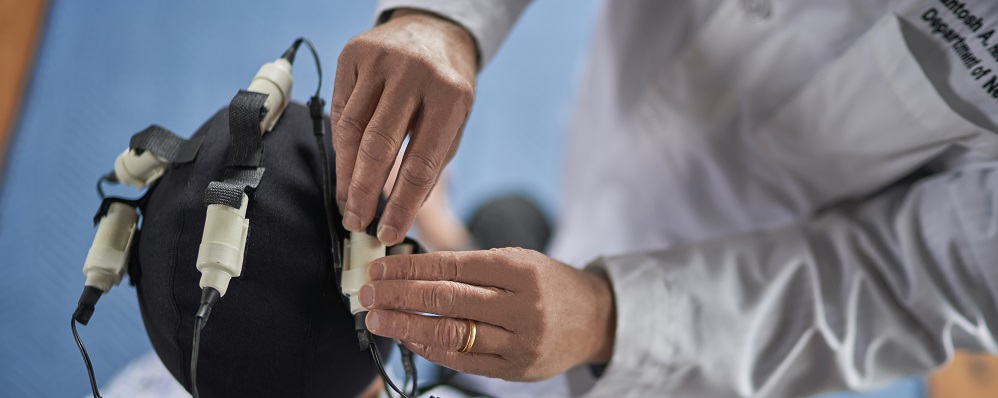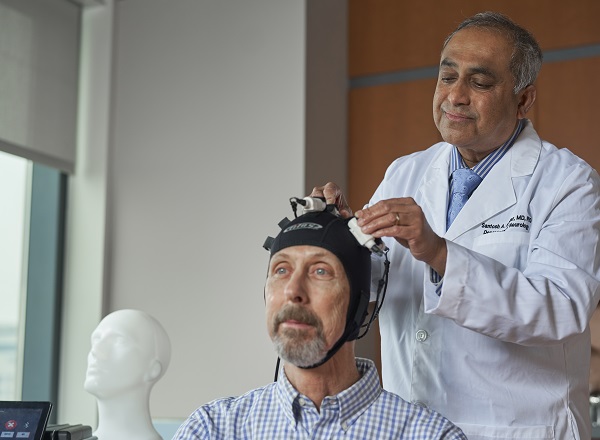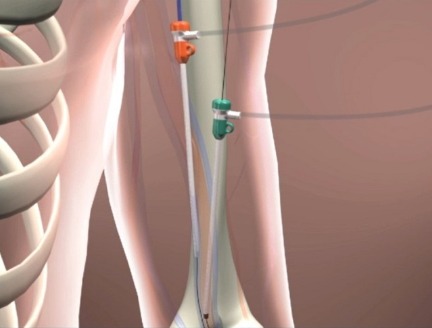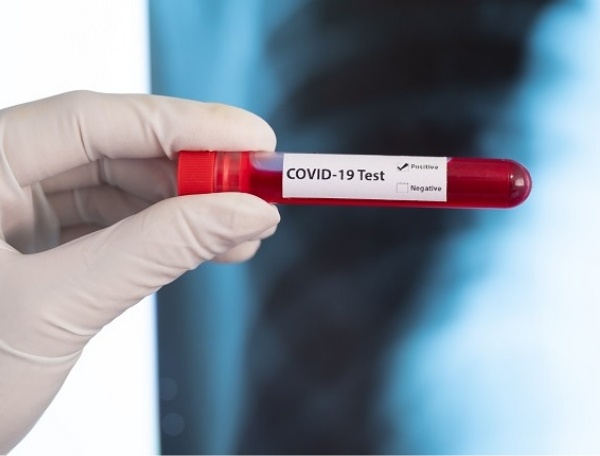


Clinical Research
Revolutionary Stroke Recovery
TRPMS cap reveals—and recovers—brain function

The electromagnetic cap, using TRPMS and a smart phone app to stimulate precise points in the brain, provides stroke patients with an affordable and portable home-based therapy.
What do songbirds, stuttering and electromagnetic stimulation have in common? A revolutionary treatment for recovery after stroke — and potential treatments for many other neurological disorders.
It all started with the riddle of stuttering, explored by Houston Methodist neurologist David Rosenfield, MD, and neuroscientist Santosh Helekar, MD, PhD. They compared the brain structures of zebra finches learning songs to those of humans learning speech and asked: How can we identify and influence brain mechanisms that affect speech? It occurred to Helekar that the answer was to develop a way to apply electromagnetic stimuli to precise, localized points in the brain — by inventing a device small enough to stimulate a songbird's brain.

Helekar worked with Henning Voss, PhD, a physicist at Weill Cornell Medical College, to invent a portable non-invasive device that uses powerful neodymium rare earth magnets, combined with tiny electric motors to produce high-speed oscillations: electromagnetic bursts that resemble the wave patterns that might occur in the brain during learning. Eventually, the researchers attached the motorized magnets, small enough to enclose in capsules, to a neoprene cap that fits snugly on the human head. Controlled by a smart phone app, the cap provides patients with an affordable and portable home-based therapy.
An ongoing clinical trial conducted by Helekar and David Chiu, MD, Elizabeth Blanton Wareing Chair in the Eddy Scurlock Stroke Center in the Stanley H. Appel Department of Neurology, will be completed in March using the TRPMS cap to attempt to promote recovery from stroke.
As the first project to be selected for funding by the Houston Methodist Translational Research Initiative, the cap is fulfilling the fund’s mission of promoting clinical translation. The patent portfolio for the technology underlying the cap has been licensed by Seraya Medical Systems, LLC, which has supported one clinical trial in the past year and plans to extend the trials for additional medical conditions. Seraya also plans to design a commercial version of the cap, for which it will apply for FDA marketing approval.
Data demonstrating the cap's ability to diminish stuttering was presented at the 2018 American Neurological Association meeting. Following a poster presentation co-authored by Rosenfield and Helekar, their research was awarded a "blitz" presentation for an audience of neurologists. Rosenfield, who is the Chair in Speech and Language in the Stanley H. Appel Department of Neurology, reported their results: When using the cap to strengthen the connection between the Broca’s and Wernicke’s speech areas in the brain, eight out of nine study participants showed improved fluency of speech.
Fifty years of research show that the brain changes when stimulated repeatedly and often. Simultaneous repeated stimulation of two connected points in the brain enhances the connections between them — this is how learning occurs — and stimulation using oscillations might create a better effect.
Santosh Helekar, MD, PhD
Associate Professor of Neurology
Stanley H. Appel Department of Neurology
Houston Methodist
Called transcranial rotating permanent magnet stimulation, or TRPMS, the patented technology uses multi-focal stimulation to manipulate impulses at several points in the brain simultaneously, exciting or inhibiting areas responsible for specific functions. Following a stroke and its resulting lesions, the cap can stimulate nearby healthy tissue to take over functioning in damaged areas. For example, healthy tissue surrounding lesions in the motor cortex may be stimulated to send instructions that induce muscle groups to continue functioning.
Helekar SA and Voss HU. (2016) Transcranial brain stimulation with rapidly spinning high-field permanent magnets. IEEE Access, 4: p. 2520-2528. DOI: 10.1109/ACCESS.2016.2568739.
LaVonne Carlson, March 2019








